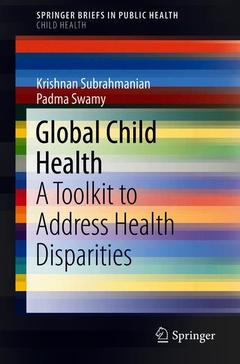Global Child Health, 1st ed. 2018 A Toolkit to Address Health Disparities SpringerBriefs in Child Health Series

This timely resource brings child health to the forefront of global health and the crucial goal of universal equity of care. Its resource-based framework offers contemporary perspective on factors driving child health disparities, specific vulnerabilities of underserved children, and ways readers can become effective advocates for children. The book critiques current child health policy worldwide, examining both policies that are helping to alleviate and are contributing to further inequities. And the authors provide an extensive toolkit to aid professionals in multidimensional screening for child, newborn, maternal, and post-natal health as well as socioeconomic determinants of health.
Included in the coverage:· What is global health?
· The current state of global child health and disparities
· Global health disparities in high-resource settings
· Pathologies disproportionally affecting the underserved
· Policy and advocacy framework
· Navigating the domestic resources (an advocate?s well child check)
Global Child Health will find a ready audience among child health providers (physicians, advanced practice providers, nursing staff, social workers, allied healthcare providers, public health professionals), medical educators (medical schools, departments of pediatrics, schools of public health, nursing schools and programs, schools of allied health), and child health policymakers (staff at USAID, Health and Human Services, health services researchers in child and global health policy, health advocacy-related nonprofit organizations).
Chapter 1) Define Global (Child) Health
- Utilize different definitions from existing literature to describe global (child) health
- Conclude with statement on global child health as addressing the health of ALL of children including those in the USA.Chapter 2) International Setting:
- Causes and epidemiological trends of infant and child mortality and morbidity in developing countries- Recognize major underlying socioeconomic and political determinants of infant/child health
- Preventative measures for reducing mortality in children under 5 years of age- Epidemiology of neonatal mortality
- Prevention and treatment of neonatal mortality- Trends in emerging infectious diseases (Zika, Ebola, etc.)
Chapter 3) Domestic Setting:
- Causes and epidemiological trends of infant and child mortality and morbidity in the United States
- Recognize major underlying socioeconomic and political determinants of infant and child health in the United States
- Preventative measures for reducing mortality in children under 5 years of age
- Epidemiology of neonatal mortality in the United States
- Prevention and treatment of neonatal mortality
Part 2: Who and What Do We Treat?
Chapter 4) Specific Populations in Global Child Health in the USA
- Immigrant and Refugee Health
- International adoptees
- Refugee, internally displaced orphans
- Child trafficking, child soldiers, and child labor
- Settings of Domestic Underserved Children§ Federally Qualified Health Centers
§ Border Health§ Reservation Health
Chapter 5) Malnutrition, Infectious disease, and NCDs disproportionately affecting the underserved- Anthropomorphic Measures
- Micronutrient deficiencies- Describe the interaction between malnutrition and infectious disease
- Malaria- Pneumonia
- Diarrhea and dysentery
- Measles
- Neonatal infections
- HIV/AIDS- Tb
- Typhoid- Dengue
- Meningitis
- Vaccine preventable diseases and immunizations in developing countries
- Impaired cognitive development and associated morbidity
- Diabetes
- Other NCDs
Part 3: How Do We Treat It?
Chapter 6) International: The Policy tool kits
- Specific Reference texts and standardized guidelines
- Humanitarian emergencies and disasters- Major governmental and non-governmental organizations
- Millennium Development Goals (MDGs)Chapter 7) Navigating the Domestic Resources (An Advocate's Well Child Check)
- Healthy People 2020
- Insurance and Access
- Literacy
- Food Access and Insecurity
- Environmental Health
- Housing Insecurity- School Disparities
- Specialty Care Access with reference to NCDs- Using social media
Part 4: Why This Work Is Important; Conclusion
Presents and defines global health in the national context
Compares and contrasts international and national global child health
Offers guidance on advocating for child health both internationally and locally by providing readers with an advocacy tool kit and resources
Identifies and describes the challenges faced by underserved communities in the United States
Defines the presentation, diagnosis, and treatment of the most common ailments affecting underserved children
Date de parution : 05-2018
Ouvrage de 101 p.
15.5x23.5 cm
Thèmes de Global Child Health :
Mots-clés :
global child health; global health international and local; advocating for child health globally; social determinants of health; vulnerable children; child poverty; infant and child morbidity and mortality; child health policy; human trafficking in children; refugee and immigrant child health; international child health; national child health; domestic child health; health disparities; health equity; underserved children; epidemiology; socioeconomics; prevention and treatment; neonatal health



